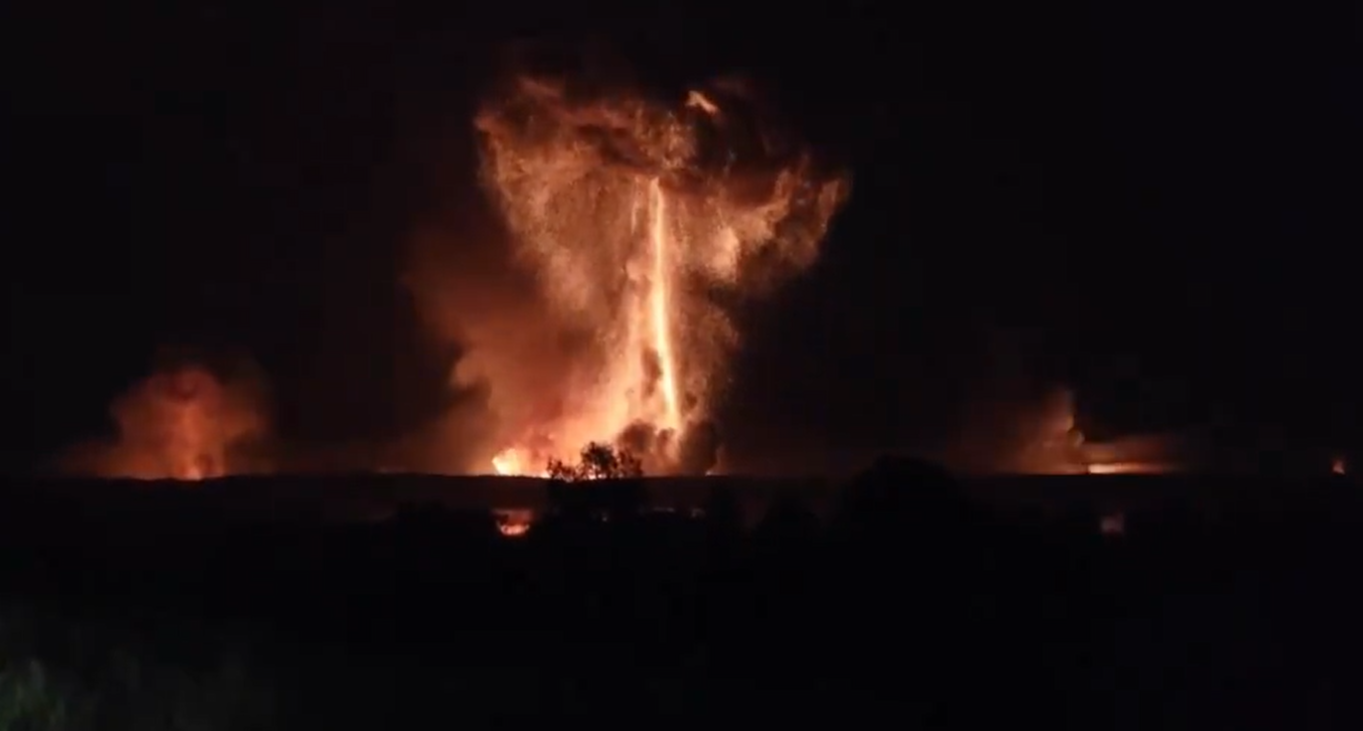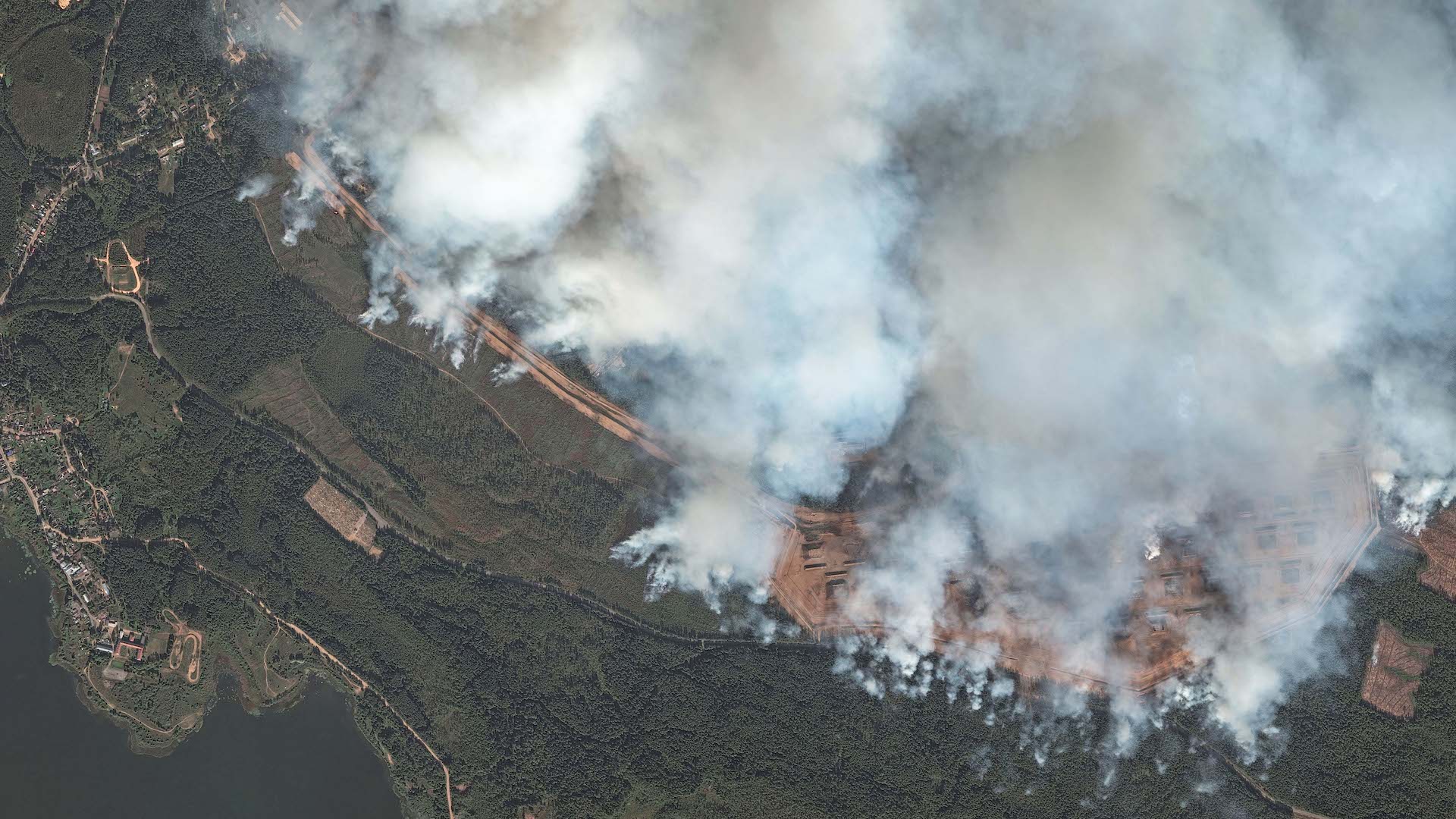Ukraine's Massive Attack on Russia in Toropets - Pushing for WW3?

In a daring overnight operation, Ukraine claims to have successfully destroyed a significant weapons stockpile deep within Russian territory. This audacious attack, utilizing long-range drones, targeted a facility in Toropets, a town in the Tver region of western Russia.
The strike has sent shockwaves through both military and diplomatic circles, raising questions about the escalating nature of the conflict and the potential implications for future engagements.
Sign up for Drishtikone - Online Magazine on Geopolitics and Culture from Indian Perspective
Join the over 2500 intellectuals from the movie industry, think tanks, governments, industry, research, and universities in reading a detailed and in-depth insightful newsletter every week.
No spam. Unsubscribe anytime.
Please Contribute to Drishtikone
What we do takes a lot of work. So, if you like our content and value the work that we are doing, please do consider contributing to our expenses. Choose the USD equivalent amount in your own currency you are comfortable with.
The Attack: Precision, Power, and Implications
The attack targeted the 107th Arsenal of the Main Missile and Artillery Directorate of the Russian Ministry of Defense, a sprawling facility that stores up to 240 tons of explosives. The strike occurred on September 18, 2024, causing a series of powerful explosions that continued for hours.

Such a massive explosion caused some to even equate it to a nuclear attack.
⚡️Earthquakes in 🇷🇺Toropets are similar in magnitude to nuclear tests, i.e. there hundreds or even thousands of tons of explosives detonate at the same time. pic.twitter.com/a6qBBcOYwC
— 🪖MilitaryNewsUA🇺🇦 (@front_ukrainian) September 18, 2024
It was a well-coordinated attack the smoke of which could be visible from the space as well.
The damage from this attack to Russia is substantial.
Destroyed Assets
The ammunition depot reportedly contained:
- S-300 and S-400 air defense missiles
- Iskander ballistic missiles
- North Korean KN-23 ballistic missiles
- Guided bombs
- Artillery shells
- Other explosives
The total amount of destroyed munitions is estimated at around 30,000 tons
The assault on the Russian weapons depot in Toropets, Tver region, marks a significant escalation in Ukraine's offensive capabilities. This operation not only demonstrates Ukraine's growing technological prowess but also signals a shift in its military strategy.
The Drone Strike: A Testament to Technological Advancement
Ukraine's use of approximately 100 explosive-laden uncrewed aircraft in this operation showcases its expanding drone warfare capabilities. This technologically sophisticated approach allowed for a precise strike on a target located roughly 500 kilometers from Ukraine's northern border, well beyond the range of conventional artillery.
The success of this mission highlights the evolving nature of modern warfare, where unmanned systems can penetrate deep into enemy territory with minimal risk to personnel. It also underscores the increasing importance of drone technology in military operations, potentially reshaping the dynamics of future conflicts.
In terms of military warfare, this is a new level of escalation.
Target Significance: A Critical Blow to Russian Military Resources
The targeted facility in Toropets was reportedly housing a large cache of Iskander and Tochka-U missiles, as well as glide bombs. These weapons systems are crucial components of Russia's military arsenal, particularly in its ongoing operations against Ukraine.
The Iskander missile system, known for its accuracy and ability to evade missile defense systems, has been a cornerstone of Russia's tactical missile capabilities. Similarly, the Tochka-U, while older, remains a potent short-range ballistic missile system. The destruction of these assets, if confirmed, would represent a significant setback to Russia's offensive capabilities in the region.
Furthermore, the loss of glide bombs - precision-guided weapons that have been extensively used in the conflict - could impact Russia's ability to conduct accurate strikes on Ukrainian targets. This potential degradation of Russia's offensive capabilities could provide Ukraine with a tactical advantage in future engagements.
Geopolitical Ramifications: Escalation and International Reaction
The strike on Toropets raises significant questions about the potential escalation of the conflict. By targeting a facility deep within Russian territory, Ukraine has demonstrated both the will and the capability to take the fight to its adversary's homeland. This development could potentially alter the strategic calculations of both sides and their international supporters.
The international community's response to this attack will be crucial. Western nations, particularly the United States, may find themselves in a delicate position. While they have been supportive of Ukraine's defensive efforts, the use of Western-supplied weapons for strikes on Russian soil could potentially cross red lines and lead to increased tensions.
Moreover, this attack might influence ongoing discussions about providing Ukraine with long-range missiles. The success of this drone strike could bolster arguments in favor of supplying such weapons, while simultaneously raising concerns about potential escalation.
Please do read our last newsletter which shares how the Western Deep state may want to push for the war to escalate! Meanwhile the peace initiatives by PM Modi may be to thwart the Deep State moves.
Governor Igor Rudenya's Response and the Local Impact
The reaction of Tver region Governor Igor Rudenya to the attack on Toropets provides insight into the Russian authorities' approach to managing the aftermath of such incidents and communicating with the public.
Official Statement and Evacuation Efforts
Governor Igor Rudenya's response to the incident was swift but measured. In a video statement relayed through the state-owned news agency TASS, he announced the evacuation of Toropets residents due to a fire caused by falling drone debris. This official narrative carefully avoided mentioning the nature of the target or acknowledging a successful Ukrainian strike.
The governor's presence at the scene, as evidenced by his attendance at a meeting of the operational headquarters in Toropets, demonstrates the seriousness with which local authorities are treating the incident. It also suggests an attempt to project an image of control and responsiveness in the face of a potentially destabilizing event.
However, the sounds of multiple explosions audible in the background of Rudenya's statement contradict the official narrative of a simple fire caused by drone debris. This discrepancy highlights the challenges faced by Russian authorities in managing information about attacks on their territory, especially when the evidence of a significant incident is apparent to local residents.
Local Impact and Civilian Response
The evacuation of Toropets residents underscores the immediate impact of the attack on the local civilian population. While the official reasons given for the evacuation were limited to fire safety, the reality of explosions and the potential for further detonations likely created a atmosphere of fear and uncertainty among the town's inhabitants.
The incident in Toropets may have long-lasting effects on the local community. Beyond the immediate disruption caused by the evacuation, residents may face ongoing concerns about their safety and the potential for future attacks. This could lead to increased pressure on local and national authorities to enhance air defenses and improve early warning systems in the region.
Furthermore, the attack could have economic implications for Toropets and the broader Tver region. The presence of a significant military installation likely provided economic benefits to the area. Any damage or perceived vulnerability of such facilities could impact local employment and economic activity.
Challenges in Information Management
Governor Rudenya's careful wording and the discrepancy between the official explanation and the audible explosions highlight the challenges faced by Russian authorities in managing information about attacks on their soil. The incident in Toropets demonstrates the difficulty of maintaining a controlled narrative in an age of instant communication and widespread access to information.
Local residents, hearing explosions and witnessing the evacuation, are likely to seek information from various sources, including social media and international news outlets. This creates a complex information environment where official statements may be scrutinized and questioned, potentially eroding trust in local leadership.
The situation also puts Governor Rudenya in a delicate position, balancing the need to inform and protect the local population with potential pressures from higher authorities to downplay the significance of the attack. His handling of this incident could have implications for his political future and his relationship with both the local populace and the central government in Moscow.
The Weapons Depot: Strategic Importance and Vulnerability
The weapons storehouse in Toropets, Tver region, targeted in this attack, holds significant strategic importance for Russia's military capabilities. Understanding its role and the implications of its targeting provides crucial context for the broader conflict.
Construction and Capacity: A Modern Military Asset
Built in 2018, the weapons depot in Toropets represents a relatively new and presumably state-of-the-art facility in Russia's military infrastructure. Its construction less than a decade ago suggests that it was designed with modern security and storage standards in mind, potentially incorporating lessons learned from previous conflicts and technological advancements.
The facility's designation as one of the Russian Ministry of Defense's largest arsenals underscores its strategic importance. Such a depot would likely be equipped to store a diverse array of weapons systems, from conventional munitions to more sophisticated missile systems like the Iskander and Tochka-U.
The size and capacity of this depot indicate its role as a key node in Russia's logistics network, potentially serving as a distribution hub for weapons and ammunition to various fronts, including the ongoing conflict in Ukraine. Its location in western Russia, while distant from the current front lines, positions it as a critical rear-echelon facility supporting Russia's military operations.
Security Measures and Perceived Invulnerability
Former Russian Deputy Minister of Defense Dmitry Bulgakov's statement about the arsenal being well-protected from external impact reflects the confidence that Russian military leadership had in the facility's defenses. This perception of invulnerability may have influenced decisions about the types and quantities of weapons stored at the site.
Typical security measures for such a facility would likely include:
- Advanced perimeter security systems
- Anti-aircraft defenses
- Hardened storage facilities resistant to conventional attacks
- Sophisticated fire suppression systems
- Round-the-clock armed security personnel
The apparent success of the Ukrainian drone strike, if confirmed, calls into question the effectiveness of these defensive measures against new and evolving threats. It highlights the potential vulnerabilities of even well-protected static targets to innovative attack methods, particularly those involving swarms of small, hard-to-detect drones.
Implications of the Attack on Russian Military Strategy
The targeting of this specific depot in Toropets could have far-reaching implications for Russian military strategy and logistics. The loss or damage of a significant weapons cache could disrupt supply lines and potentially impact Russia's ability to sustain intense military operations in Ukraine.
Moreover, the successful strike on a facility previously thought to be well-protected may necessitate a reevaluation of security measures at similar installations across Russia. This could lead to increased resources being diverted to rear-area defense, potentially at the expense of frontline operations.
The attack also demonstrates Ukraine's ability to strike deep within Russian territory, which could force a recalibration of Russian military planning. The need to defend a much larger area against potential drone strikes might stretch Russian air defense capabilities and alter the deployment of key assets.
Verification and International Observation
While Ukraine claims success in this operation, independent verification of the attack's extent and impact remains challenging. The use of satellite data and international monitoring systems provides some corroboration, but questions remain.
NASA FIRMS Data: Corroborating Evidence
The NASA Fire Information for Resource Management System (FIRMS), which tracks fires worldwide using satellite data, recorded significant heat signatures on the outskirts of Toropets overnight. This data aligns with the timeframe of the alleged Ukrainian attack and provides some independent corroboration of a significant event occurring in the area.
The heat signatures detected by FIRMS correspond to a fenced compound containing multiple hangars, as observed in satellite imagery. This correlation between the reported target - a weapons depot - and the observed heat signatures lends credibility to Ukraine's claims.
However, it's important to note that while FIRMS data can indicate the presence of intense heat or fire, it cannot definitively confirm the cause of such phenomena. The system's primary purpose is to detect fires, not to verify military operations or explosions.
Challenges in Independent Verification
The nature of the target - a military installation deep within Russian territory - presents significant challenges for independent verification of the attack's details and outcomes. Access to the site for international observers or journalists is likely to be heavily restricted, if permitted at all.
Russian authorities have a vested interest in controlling the narrative surrounding any attack on their soil. This could lead to limited or carefully curated information being released about the incident, making it difficult for outside observers to assess the true extent of any damage or the specific weapons systems affected.
Furthermore, the use of long-range drones in this operation means that there are unlikely to be any Ukrainian forces or observers near the target who could provide first-hand accounts of the attack's results.
The Role of Open-Source Intelligence
In the absence of on-the-ground verification, open-source intelligence (OSINT) techniques become crucial in assessing the validity of claims made by both sides. This includes:
- Analysis of satellite imagery before and after the alleged attack
- Monitoring of social media posts from local residents
- Scrutiny of official statements and state media reports
- Examination of any video or photographic evidence that emerges
The international intelligence community and independent analysts will likely be closely monitoring these sources to piece together a more complete picture of what transpired in Toropets.
However, the reliability and interpretation of such open-source information can be challenging, particularly in a conflict where information warfare plays a significant role. Misinformation and deliberate attempts to obscure facts can complicate efforts to establish a clear and unbiased understanding of events.
Is it a watershed attack?
It very well could be.
What is being seen as a Ukrainian drone strike on the weapons depot in Toropets, Tver region, represents a significant escalation in the ongoing conflict between Russia and Ukraine.
This bold operation, if confirmed, demonstrates Ukraine's growing capabilities in long-range warfare and its willingness to take the fight deep into Russian territory.
The attack raises important questions about the vulnerability of Russian military installations, the effectiveness of drone warfare, and the potential for further escalation in the conflict. It also highlights the challenges faced by local authorities, such as Governor Igor Rudenya, in managing the aftermath of such incidents and communicating with the public.
As the situation continues to unfold, the international community will be closely watching for any shifts in the strategic balance between the two nations and the potential implications for global security. The incident in Toropets may well mark a new chapter in the ongoing conflict, one that could reshape military strategies and alliances in the region and beyond.
